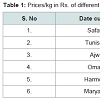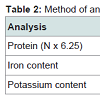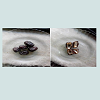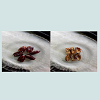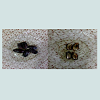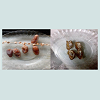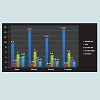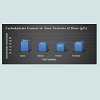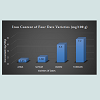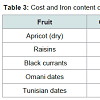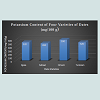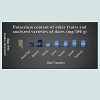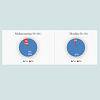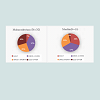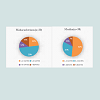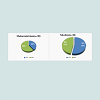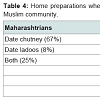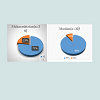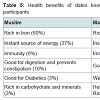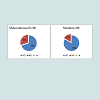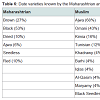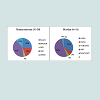Journal of Food Processing & Beverages
Download PDF
Research Article
*Address for Correspondence: Patel Mariyam, Department of Food Processing and Preservation, Nirmala Niketan, College of Home Science, Affiliated to University of Mumbai, New Marine Lines, Mumbai, Maharashtra, 400020, India, Tel: 09022286540; E-mail: mariamp_150@yahoo.com
Citation: Mariyam P, Mary V. Nutritional Analysis (Macronutrients, Potassium and Iron Content) of Four Palm Date Varieties (Phoenix Dactylifera L.) and Study of Consumption Pattern among Muslim and Maharashtrian Community (2014). J Food Processing & Beverages. 2015;2(1): 9.
Copyright © 2015 Mariyam et al. This is an open access article distributed under the Creative Commons Attribution License, which permits unrestricted use, distribution, and reproduction in any medium, provided the original work is properly cited.
Journal of Food Processing & Beverages | ISSN: 2332-4104 | Volume: 3, Issue: 1
Submission: 24 June 2015 | Accepted: 30 July 2015 | Published: 05 August 2015
On the basis of the survey conducted, it was found that the Ajwa, Safawi, Omani and Tunisian varieties were consumed and purchased at a higher rate among the customers. Hence,they were chosen as the samples for the study.
b) Study of consumption pattern among Muslim and Maharashtrian community was done by the questionnaire tool. The survey was carried out among 30 participants from each community.
The moisture analysis in the present study was carried out by oven drying method [19]. The moisture content ranged from 9.3- 14.8%. The moisture content of Ajwa, Safawi, Omani and Tunisian variety were found to be 9.3, 14.4, 11.5 and 14.8% respectively.
Date palm has been found to be an important bio energy production source as they are found to contain about 70% of carbohydrates [35]. Date has one of the highest sugar levels, 60-65%, among all fruits. It is reported that dates are important from the point of view of enabling sugar to enter the body and prevent blood pressure from dropping. Their high calorific value strengthens people weakened by illness or suffering from extreme fatigue [36].
The recommended dietary intake of iron for Indians is:
Potassium is a very important mineral to the human body for cellular and electrical functions (Figure 8). It is one of the main blood minerals called “electrolytes” [41].
Other functions include: build proteins, acts as a co-factor in carbohydrate metabolism, helps in building muscle and reduce muscle soreness that results from training [42], control the acidbase balance- potassium balance influences the cellular acid-base conditions by regulating the H+ ion concentration in the cell [43].
Consumption pattern of dates among the Muslim and Maharashtrian community
Frequency of consumption: In the Muslim Community, the consumption was high on daily basis (29%), once a week (30%) and once a month (37%) while in the Maharashtrian community, the dates were consumed once a week (37%) and very less (30%) (Figure 11).
Amount of dates consumed at a time: The amount of dates consumed at a time among the two communities differed to some extent (Figure 12). While most Muslim participants (52%) prefer consuming 1-2 dates at a time most of the Maharashtrians (50%) consumed 3-4 dates and some even preferred consuming 7-8 dates at a time. One of the prime reason for this may be that Muslim consume dates on daily basis more often hence their consumption is 1-2 dates per day while Maharashtrians consume them once a week and less often hence they prefer consuming more at a time.
Incorporation of dates into home preparation: Number of Maharashtrian and Muslim Participants incorporating dates in home preparations (Figure 13).
Home preparations made using dates: It was found that Maharashtrians mostly use dates in making date chutney and date ladoos while Muslims use dates in variety of delicacies like date chutney, kheer, cakes, custards, halwa and date paste for milkshake (Table 4).
Awareness about the health benefits of dates (N=30): About 90% and 73% of the Muslim and Maharashtrian participants claimed they knew the health benefits of dates (Figure 14).
Health benefits known to the participants: Many of the participants from both communities mentioned more than one benefits of date (Table 5). Maximum participants whether Muslim (60%) or Maharashtrians (74%) considered date as a rich source of iron.
Awareness about the varieties of date: About 70% and 83% of the Maharashtrian and Muslim participants respectively claimed they were aware of the varieties of dates (Figure 15).
Varieties known: From the survey it was found that Maharashtrian participants knew the varieties according to the color of the fruit. 53% Maharashtrians participants preferred black dates (Table 6). Many participants from both the communities knew multiple varieties. The actual names of the varieties were not known whereas mostly majority of the Muslim participants were well versed with the name varieties available in the market and knew more than one variety.
Variety preferred: Maharashtrians mostly preferred any variety of dates (41%) followed by more preference towards black dates (26%). In Muslim community although 52% participants preferred any variety of dates, about 32% preferred the Ajwa variety (Figure 16). Ajwa dates are date fruit from Madinah Monawara which is a holy place for Muslims and Ajwa variety are considered to be medicine to every disease or illness by Muslims. The messenger (Sallallaahu Álayhi Wasallam) said whoever has taken seven Ajwa dates every morning he will not be harmed on that day by poison or magic. “[Saheeh al-Bukhaaree (5445) (5768) (5769) (5779)]” [47].
Due to its sacredness probably the consumption of that variety is high among Muslims.
Nutritional Analysis (Macronutrients, Potassium and Iron Content) of Four Palm Date Varieties (Phoenix dactylifera L.) and Study of Consumption Pattern among Muslim and Maharashtrian Community (2014)
Patel Mariyam* and Varghese Mary
- Department of Food Processing and Preservation, Nirmala Niketan, College of Home Science, Affiliated to University of Mumbai, India
*Address for Correspondence: Patel Mariyam, Department of Food Processing and Preservation, Nirmala Niketan, College of Home Science, Affiliated to University of Mumbai, New Marine Lines, Mumbai, Maharashtra, 400020, India, Tel: 09022286540; E-mail: mariamp_150@yahoo.com
Citation: Mariyam P, Mary V. Nutritional Analysis (Macronutrients, Potassium and Iron Content) of Four Palm Date Varieties (Phoenix Dactylifera L.) and Study of Consumption Pattern among Muslim and Maharashtrian Community (2014). J Food Processing & Beverages. 2015;2(1): 9.
Copyright © 2015 Mariyam et al. This is an open access article distributed under the Creative Commons Attribution License, which permits unrestricted use, distribution, and reproduction in any medium, provided the original work is properly cited.
Journal of Food Processing & Beverages | ISSN: 2332-4104 | Volume: 3, Issue: 1
Submission: 24 June 2015 | Accepted: 30 July 2015 | Published: 05 August 2015
Abstract
There is high prevalence of anemia, hypertension among the human population today. Consumption of right food at the right time in the right amount plays a crucial role. Date is a fruit packed with nutrients and having multiple health benefits. It is reported that dates are a rich source of iron and potassium both playing an important role in anemia and hypertension respectively. A number of date varieties are available in the market having varied nutritional compositions.Hence, it is probably of key importance for consumers to be aware of which variety of dates provides the most beneficial effect on health. The different varieties of dates available in the market are not generally labeled with their nutritional profile. Due to this the consumers might not be aware of the various varieties and the most beneficial ones available in the market.Hence, the present study was aimed at estimating and comparing the macronutrients (moisture, ash, carbohydrate, fat, crude fiber), iron and potassium content of four date varieties namely Ajwa, Safawi, Omani and Tunisian dates and studying the consumption pattern of dates among the Muslim and Maharashtrian community.
The chemical analysis was carried out using AOAC methods for estimation. The ash, carbohydrate, fat, fiber and moisture content did not show a significant difference across the varieties. The iron content of the four varieties was found to be 0.85, 1.66, 5.5 and 7.2 mg/100 g respectively. All the date varieties were found to be high in potassium (490-590 mg/100 g) with Omani variety having the highest potassium content (590 mg/100 g). Ajwa variety was found to have the highest carbohydrate content (76.6 g %) and Omani variety having the least carbohydrate content (75.1 g %).
Study of consumption pattern was carried out among Muslim and Maharashtrian community with 30 participants from each community. A varied consumption pattern was observed among the two communities with respect to frequency of consumption, incorporation of dates in home preparation and awareness regarding the varieties.
This study can be an important step towards labeling of date varieties in order to educate the consumers.
Introduction
Diet plays an important role in maintaining well being and prevention of various diseases and fruits are considered vital component of a daily diet [1]. Inclusion of fruits in our daily diet is highly recommended. This belief is due to the content of vitamins, fiber and phytochemicals that fruits contain the latter being responsible in part for the antioxidant properties of fruits and food of their origin [2,3]. They have also been found to prevent or reduce the risk of coronary heart diseases [4,5], cancer and other chronic diseases.Date fruit (Phoenix dactylifera Linn.) is one such consortium of nutrients namely carbohydrates, dietary fiber, minerals and vitamins as well as high in phenolic content, which reflects its antioxidant activity [6]. It is probably one of the most ancient cultivated trees in the world. It is an important plantation crop for many countries extending from North Africa to the Middle East including many states of the Arabian Gulf Cooperation Countries (GCC) [7].
The world production of dates has increased considerably over 40 years. Asia is the largest importer and consumer of date fruits in the world. With in Asia, China and India are the major importers of date fruits [7].
The incidence of diseases is on a rise due to improper diet, irregular dietary patterns, consumption of processed foods, and exclusion of fruits from diet. According to WHO statistics diabetes mellitus, ischemic heart diseases and stroke are major causes of deaths globally [8]. Hence inclusion of proper amount of nutrients in one’s diet is an important aspect for prevention and reduction of risk of these deadly diseases.
Date fruit can be mentioned as an ideal food to be included in daily diet as it provides a wide range of essential nutrients and potential health benefits [9]. It is still considered as a staple food by many people in the world [10]. Dates are available throughout the year as they can be refrigerated and stored for a long period of time.
Date fruit is found to have low glycemic index and hence can be used as a source of energy by the diabetic population in recommended proportion [11]. They are high in potassium and low in sodium content and hence can be included in DASH diet [12]. They are also a rich source of dietary fiber which can help in reduction of risk of coronary diseases as well as colon cancer [13]. It is a good source of phenolic compounds and hence has a large scope of being included in the development of functional foods or as food ingredient [14]. Many studies have been carried out to determine the antioxidant activity in different cultivars of dates [15].
There are about 250 named cultivars of date fruit. Each cultivar differs in terms of amount of nutrients present and the level of maturity [16].
Keeping this in view, an attempt has been made to estimate and compare 4 different date palm (Phoenix dactylifera Linn.) varieties namely Safawi, Tunisian, Omani and Ajwa on the basis of:
1. Macronutrients
2. Potassium and Iron content
3. Study of consumption pattern of the date fruit in Muslim and Maharashtrian community
Knowledge regarding which date cultivar contains reasonable amount of nutrients and so may deliver certain health benefit can help in its use in various health specific diet planning, food product development and reflect the need of nutritional labeling of date varieties. Also a survey among the two communities about this fruit can help in determining whether there is a gap about awareness in two varied communities assumed to be the most consuming group (Muslim) and least consuming group (Maharashtrian) and also help in spreading awareness about it.
Methodology
Sample selection
A random survey was carried out among the students of Nirmala Niketan, College of Home Science, wholesalers at Crawford market and American Dry fruit center (Fort) in order to determine which four varieties were sold, purchased and consumed in a higher quantity [17]. The price/kg for the four varieties is shown in the Table 1.
Details of analysis
The samples of 4 varieties of dates (Phoenix dactylifera Linn.) namely Tunisian, Safawi, Ajwa and Omani dates were collected from Crawford market, Churchgate, Mumbai.
Moisture content: The Moisture content analysis of the date varieties was carried out by the oven drying method [18].
Carbohydrate content: The carbohydrate analysis is carried out through difference method [18].
Crude fat analysis: Estimation of the crude fat content in the date varieties was done by Soxhlet’s method [18].
Crude fiber estimation: The crude fiber content was analyzed by the basic method developed by Hennenberg et al. in Germany which includes defatting by use of petroleum ether, treatment with sulfuric acid and sodium hydroxide followed by oven drying and ashing [19].
Ash analysis: Determination of the ash content was carried out by dry ashing method [18].
a) Protein and Micronutrient analysis (iron and potassium) was out sourced. The protein, potassium, iron content was out sourced to Anazeal Analyticals and Research Pvt. Limited, MIDC, Pawane, Navi Mumbai (Table 2).
Results and Discussion
Fruits normally have more than 90% water in the edible portion [19]. They are commercially dried to a particular moisture content to increase the shelf life of the product (Figures 1-5). Dates after harvest can be a subject to aging, insects, microorganisms, chemical deterioration as well as physical deterioration. Moisture reduction helps in slowing down the process of chemical reactions and growth of micro organisms and hence prevents microbial spoilage [20,21]. It brings about substantial reduction in weight and volume; minimizing packing, storage and transportation costs and enables storability of the product under ambient temperatures, features especially important for developing countries [22].According to Gopalan et al. fresh dates have a moisture content of 54%. They are sun dried and brought to a moisture content of 15% for commercial usage. According to USDA specifications (2009) the moisture content of Tunisian variety (chopped and diced) ranges between 11-15% [23].
Tunisian dates are found to be highly self preserving and have a great shelf life during storage [24].
On statistical analysis it was found that the moisture content is not significantly different across the 4 date varieties (t=9.649, p < 0.05) with mean 12.5±1.29 g %.
Protein analysis is a subject of enormous economic and social interest. Protein quantitative analysis is necessary for quality control and is a prerequisite of accurate food labeling. Protein shows differing nutritional quality or ability to support dietary needs. Protein analysis has legal, nutritional, health, safety and economic implications for food industry [25].
Dates were found to be a poor source of protein. The protein content in the current study was found to be highest in Ajwa variety (4.38 g/100 g) while maintaining a stable value (2-2.29 g/100 g) in the other 3 varieties.
According to Gopalan et al. the protein content of dried dates is reported to be 2.5 g/100 g and according to USDA specifications (2009) it is reported as 1.81 g/100 g.
According to statistical analysis, it was found that the protein content showed a significant difference among the four varieties (t= 5.553, p >0.05). The mean protein content was found to be 2.8±1.02 g%.
Fat determination is one of the key analyses performed in food industry and in public food monitoring programs in order to control production processes, ensure accurate labelling and monitor food safety [26].
A study suggests that dry fruits consumption was associated with improved diet quality and reduces adiposity in US adults [27].
The available data suggests that dates are free of saturated fat, trans fat, sodium and cholesterol. Including dates in daily diet contributes to keeping the heart healthy [28].
The fat content was found to be in the range of 5-6 g/100 g. Omani having the least fat content of 4.6 g/100 g followed by Ajwa (5 g %), Tunisian (5.6 g %) and Safawi (6 g %).
The fat content of dates reported by Gopalan et al. and USDA specifications is 0.4 g/100 g. The obtained values appear to be relatively higher than the reported values [29].
The reason behind this may be that during the post-harvest processing dates are coated with an edible film of wax or vegetable oil in order to increase the shine and the durability of product which gives them a fresh and an appealing look. This coating increases the overall fat content of the fruit [30].
By statistical analysis, it was found that there is no significant difference between the fat content of the sample (t =17.047, p < 0.05). The mean fat content was calculated to be 5.3±0.62 g %.Crude fiber is a useful parameter in food analysis. It is commonly used as chemical determination of succulence of fresh vegetables and fruits [19].
The Crude fiber content of Ajwa, Safawi, Omani and Tunisian variety was found to be 2.9, 2.9, 2.5 and 2.9 respectively. Gopalan et al. have reported the crude fiber content of dates as 3.9 g/100 g.
There is not much variance in the crude fiber content among the four varieties. On statistical analysis it was found that there was no significant difference in the fiber content of the four varieties of dates (t = 28.00, p < 0.05) with mean of 2.8±0.2 g %. On comparison with other dry fruits like dry apricots, raisins, black currants it was seen that all the analyzed date varieties (Ajwa, Safawi, Omani and Tunisian variety) have a higher crude fiber content [31].
Ash analysis is important for determination of mineral content, nutritional labeling, quality (the type and amount of minerals present), microbiological stability and processing.
Ajwa variety had the highest ash content of 1.86 g %. The ash content showed variance across the 4 varieties analyzed. The ash content of the other varieties i.e. Safawi, Omani and Tunisian was found to be 1.34, 0.67, 0.88 g % respectively.
According to Gopalan et al. the total ash content of dates is reported as 2.1 g/100 g. The analyzed results were found to be near the reported value (Ajwa=1.86 g %).
On statistical analysis it was found that the ash content was not significantly different among the 4 varieties (t=4.494, p < 0.05) with the mean as 1.1875±0.528 g %.
Carbohydrate analysis is fundamental in many areas of research. Qualitative and quantitative analysis is used to determine composition of food, beverages and their ingredients [32]. Qualitative analysis ensures that ingredient labels present accurate compositional information [33]. Quantitative analysis ensures that the added components are listed properly on ingredient labels as well as the amount of specific carbohydrate components of consumer interest is proper and their calorific value can be calculated [32].
Both qualitative and quantitative analysis can also be used to authenticate (detect food adulteration) food ingredients and products [18].
Carbohydrate analysis is also important because physicochemical properties of foods such as sweetness, appearance, stability and texture and the efficiency of many food processing operations depend on the type and concentration of carbohydrates present [34].
The carbohydrate content of the varieties was found to be in the range of 75.1-76.6%. Ajwa variety was found to have maximum carbohydrate content of 76.6% followed by Tunisian, Safawi and Omani variety (75.8, 75.4, 75.1 g %) respectively (Figure 6).
Dates are also considered significant for breaking the fast in the holy month of Ramadan by Muslims. This is because it is believed that dates are easy to digest so they don’t exhaust the fasting person’s stomach. Due to the high carbohydrate content, they have a high satiety value and hence prevent digestive disorders. As they are very rich with sugary energy they supply the body with the most important nutrient which is sugar that is irreplaceable as a nutrient for the brain cells and nerves [37].
All the four varieties considering the high carbohydrate content probably can be included in the diet recommendation for patients suffering from extreme fatigue as well as pregnant women to revitalize and regain the energy and help in stimulation of milk hormones and improve lactation for the new born.
According to the statistical analysis, it was found that there is no significant difference between the carbohydrate content of the four date varieties (t= 233, p< 0.05) and mean difference of 75.725±0.65 g %.
Iron content and potassium content
• Men -17 mg/day
• Women it is 21 mg/day
• For pregnant and lactating mothers it is 35 mg/day and 25 mg/day respectively [39].
If iron intake is low, it can lead to anemia. Iron deficiency is one of the most common nutrient deficiency affecting 1.6 billion people, almost half of preschool children and pregnant women [38].
This can in turn affect cognitive development and functions, the scholastic achievement in case of students is lower, affects athletic performance, immunity and increases maternal mortality rate.
According to research study out of 102 adolescent girls, 60 participants were anemic. A study carried out in Malaysia found that 18% of adolescent female experienced heavy menstrual loss. It was also found that 11.1% suffered from menstrual disorders [40].
Consumption of fruits rich in iron hence becomes a need for all adolescent girls’ population, pregnant and lactating mothers.
In the analysis carried out, the iron content showed a great variation among the four varieties. Ajwa variety was found to contain the least amount of iron (0.85 mg/100 g) while Tunisian variety had the highest amount of iron (7.2 mg/100 g). Omani variety has a reddish brown color which probably depicts its moderately high iron content of 5.5 mg/100 g.
The iron content of Safawi variety was estimated to be 1.66 mg/100 g.Gopalan et al. have reported iron content in fresh and dried dates as 0.85 mg and 7.2 mg respectively.According to statistical analysis, it was found that the iron content across the 4 varieties differed significantly (t=2.505, p>0.05) with the mean value of 3.8±3.03 mg/100 g.The iron content of the analyzed varieties was compared with some dry fruits which are reported to be rich sources of iron. It was found that Omani and Tunisian variety probably prove to be a good source of iron in comparison with dry apricot, raisins, black currant. It was found that both the date varieties are not only rich in iron but are also cost effective for consumption on daily basis (Table 3).
The recommended dietary intake for potassium is 3750 mg/day for men and 3225 mg/day for women [39].
Deficiency of potassium leads to hypokalemia which is characterized by weak muscles, abnormal heart rhythms and a slight rise in blood pressure [44].
Research studies suggest that potassium is beneficial for maintenance of blood pressure. Dietary supplementation of potassium can lower blood pressure in normal and some hypertensive patients. A diet with decreased potassium and increased sodium content can elevate the risk of death from heart disease.
Hypertension is reported to be fourth leading contributor to premature deaths in developed countries and seventh in developing countries. Recent findings show that nearly 1 billion adults had the problem of hypertension in 2000 and it is predicted that there can be an exponential increase to 1.56 billion by 2025.
Review of epidemiological studies suggests that the prevalence of hypertension has increased in both urban and rural subjects and presently is 25% in urban adults and 10-15% among rural adults [45].
According to literature, dates are a very rich source of potassium. According to USDA specifications dates contain 696 mg potassium per 100 g. Dates fulfill about 16% of the RDI/day of potassium (RDI- 3750 mg/day for men and 3225 mg/day for woman) [39].
The potassium content analyzed in the present study ranged from 490-590 mg among the four varieties. The potassium content of the Ajwa, Safawi, Omani and Tunisian varieties was found to be 520, 490, 590 and 520 mg respectively.
All the four varieties can prove to be beneficial for patients suffering with a high blood pressure and can be a part of DASH(Dietary Allowances to Stop Hypertension) [46].
According to the statistical analysis it was found that there is no significant difference (t=24.984, p< 0.05) in the potassium content across the 4 varieties. The mean potassium content is 530±4.426 mg/100 g.
The potassium content of the analyzed varieties were compared with other dry fruits like dried figs, raisins and dried prunes and found to contain 271, 543 and 313 mg/100 g of potassium respectively (Figure 9). Omani variety had the highest potassium content compared to the other dry fruits and analyzed varieties.
Awareness of the date fruit: From the survey it was found that all the participants (100%) whether Muslim or Maharashtrians were aware about the date fruit.
Consumption of date fruit: The consumption of date fruit among the Maharashtrian and Muslim community was found to vary considerably (Figure 10). Among the Maharashtrian community 90% people did consume date while 10% gave it a miss. Among the Muslim community the consumption is high although 3% participants do not consume dates.
Summary and Conclusion
Fruits are an essential part of diet filled with goodness of health and packed with a number of essential vitamins and minerals which are indispensable for the normal functioning of the body. Date fruit is one such consortium of nutrients reported to have multiple health benefits. Being a native tree in the arid regions of Asia and North Africa, dates have become an important part of the dietary pattern of people not only in the Middle Eastern countries but all over the world. It is rich in carbohydrate, dietary fiber, contains moderate amount of protein and is low in crude fat. It is a mine of minerals like Potassium, Iron, Magnesium and Boron and vitamins like B-complex vitamins [2]. The low potassium and sodium ratio in dates makes it a fruit for hypertensive patients. Other health benefits include low glycemic index, lowers cholesterol levels, increases iron absorption and has also been reported to have a preventive effect on cardiovascular diseases and some types of cancer. Date fruit has been reported to have around 400 cultivars out of which 250 cultivars are named. Each differs in their nutritional composition and stages of maturity, shape, size and color.In this study a comparative analysis of macronutrients, iron and potassium of four date varieties (Phoenix. dactylifera. Linn) namely Ajwa, Safawi, Omani and Tunisian and consumption pattern of dates among Muslim and Maharashtrian community. The objective of this study was to compare and find out which variety can provide best in terms of health benefits and determine the awareness of dates among the Maharashtrian and Muslim community.
The selection of four varieties of dates to be analyzed was done by random interviewing of students of Nirmala Niketan, College of Home Science and the wholesalers at Crawford market and shopkeeper of American dry fruit center, Fort for the most purchased varieties of dates by the people. By the mentioned method, the Ajwa, Safawi, Omani and Tunisian varieties were chosen for the study.
The macronutrients, iron and potassium analysis were carried out by standardized procedures given by AOAC (Methodology chapter). The moisture analysis was carried out by oven drying method [18]. The moisture content of Ajwa, Safawi, Omani and Tunisian variety was found to be 9.3, 14.4, 11.5 and 14.8% respectively. On statistical analysis it was concluded that there is no significant difference in the moisture content of the four varieties (t=9.649, p < 0.05). The mean moisture content was calculated to be 12.5± 1.29 g %.
Ash analysis was carried out by dry ashing method [18]. The ash content of the four varieties namely Ajwa, Safawi, Omani and Tunisian was found to be 1.86 g %, 1.34 g %, 0.67 g %, 0.88 g % respectively. The ash content across the four varieties did not show significant difference (t=4.494, p< 0.05) with the mean as 1.1875±0.528 g %.
Iron and potassium content analysis were out sourced and carried out by Atomic absorption spectroscopy and flame photometry respectively. The iron content of Ajwa, Safawi, Omani and Tunisian variety was found to be 0.85, 1.66, 5.5 and 7.2 mg/100 g respectively. On applying statistics it was found that the iron content differed significantly (t=2.505, p>0.05) with the mean value of 3.8±3.03. Potassium content of Ajwa, Safawi, Omani and Tunisian variety was found to be 520, 490, 590, 520 mg/100 g respectively and did not differ significantly across the four varieties. The mean potassium content was calculated to be 530±4.426 mg/100 g.
The carbohydrate content was calculated by difference method [18]. The carbohydrate content of Ajwa, Safawi, Omani and Tunisian variety was found to be 76.6, 75.8, 75.4 and 75.1 g/100 g respectively. The carbohydrate content did not differ significantly across the four varieties (t= 23.3, p< 0.05). The mean carbohydrate content was calculated to be 75.72±0.65 g %.
Protein content analysis was outsourced, and found to be 4.4, 2.2, 2.3 and 2 g % for Ajwa, Safawi, Omani and Tunisian variety respectively. The protein content was found to differ significantly across the varieties with mean protein content of 2.8±1.02 g %.
Fat content analysis was carried out by Soxhlet’s method [18]. The fat content of Ajwa, Safawi, Omani and Tunisian variety was found to be 5, 6, 4.6 and 5.6 g % respectively. On statistical analysis no significant difference was found in the fat content of the four varieties. The mean fat content was calculated to be 5.3±0.621 g %.
The crude fiber content was analyzed and found to be 2.9, 2.9, 2.5 and 2.9 g % for Ajwa, Safawi, Omani and Tunisian variety respectively. No significant difference was found between the fiber content of four varieties when calculated statistically. The mean crude fiber content was calculated to be 2.8±0.2 g %.
To conclude, the Tunisian and Omani variety prove to be a rich source of iron (7.2 mg and 5.5 mg/100 g) and can be made inclusive in the diet of people suffering from anemia. All the date varieties are high in potassium content (490-590 mg/100 g) can be a part of Dietary Allowances to Stop Hypertension (DASH). They can also be consumed for instant energy during extreme fatigue, illnesses due to their high carbohydrate content.
The consumption pattern was studied among 60 participants (30 from each community). The sampling was carried out randomly and the survey was done by means of the questionnaire tool. It was found that all participants whether Muslim or Maharashtrian were aware about the date fruit. The consumption of dates among Muslims was more on daily basis than in Maharashtrian which was restricted to once a week or less often. It was seen that the amount of dates consumed at a time correlated with the frequency of consumption. Muslim participants consumed dates more on daily basis hence, preferred eating 1-2 dates at a time while Maharashtrians consumed 3-4 dates at a time and some even consumed 7-8 dates at a time. Muslims incorporated dates more in home preparations (53%) than Maharashtrians (40%). Home preparations where Muslims incorporated dates are date chutney, kheer, halwa, date paste for milkshake, cakes and custards while Maharashtrians incorporated dates for making chutney and ladoos. This may be due to the fact that Maharashtrians on festive occasions prepare ladoos and chutney more while for Muslims dates is of prime importance during Ramadan month for breaking the fast and make a variety of delicacies and hence use dates in more number of dishes. Mostly all participants were aware of the health benefits of dates and most considered it a rich source of iron and instant source of energy. Regarding the awareness about the various varieties of dates, Maharashtrian participants were aware of the varieties by means of their color whereas Muslims were familiar with names of the varieties. Maharashtrians preferred consuming any date variety while about 36% Muslims preferred Ajwa variety probably due to its sacredness and religious significance.
References
- WHO/FAO (2003) Diet, nutrition and the prevention of chronic diseases. Report of joint WHO/ FAO expert consultation. WHO Technical Report Series 916, World Health Organization, Geneva.
- Sidhu JS (2006) Date fruit production and processing. In Hui YH, Handbook of fruit and fruit processing, Blackwell publication, pp. 391-419.
- Alasalvar C, Shahidi F (2013) Dried fruits: phytochemicals and health effects. Wiley-Blackwell Publishing.
- Rimm EB, Ascherio A, Giovannucci E, Spiegelman D, Stampfer MJ, et al. (1996) Vegetable, fruit, and cereal fiber intake and risk of coronary heart disease among men. JAMA 275: 447-451.
- Blomhoff R (2005) Dietary antioxidants and cardiovascular disease. Curr Opin Lipidol 16: 47-54.
- Anjum FM, Bukhat SI, El-Ghorab AH, Khan MI, Nadeem M, et al. (2012) Phytochemical characteristics of date palm (Phoenix dactylifera) fruit extracts. Pak J Food Sci 22: 117-127.
- http://www.fao.org/docrep/006/y4360e/y4360e0c.htm#bm12.
- http://who.int/mediacentre/factsheets/fs310/en/
- Al-Shahib W, Marshall RJ (2003) The fruit of the date palm: its possible use as the best food for the future? Int J Food Sci Nutr 54: 247-259.
- Erskine W, Moustafa AT, Osman AE, Lashine Z, Nejatian A, et al. (2006) Date palm in the GCC countries of the Arabian Peninsula.
- Alkaabi JM, Al-Dabbagh B, Ahmad S, Saadi HF, Gariballa S, et al. (2011) Glycemic indices of five varieties of dates in healthy and diabetic subjects. Nutr J 10: 59.
- http://www.datesaregreat.com/culinary-delights/
- Marlett, JA, McBurney MI, Slavin JL, American Dietetic Association (2002) Position of the American dietetic association: health implications of dietary fiber. J Am Diet Assoc 102: 993-1000.
- Zhang CR, Aldosari SA, Vidyasagar PS, Nair KM, Nair MG (2013) Antioxidant and anti-inflammatory assays confirm bioactive compounds in Ajwa date fruit. J Agric Food Chem 61: 5834-5840.
- Singh V, Guizani N, Essa MM, Hakkim FL, Rahman MS (2012) Comparative analysis of total phenolics, flavonoid content and antioxidant profile of different date varieties (Phoenix dactylifera L.) from Sultanate of Oman. Int Food Res J 19: 1063-1070.
- Mikki MS, AH Hegazi, Abdel-Aziz AA, Al-Taisan SM (1986) Suitability of major Saudi date cultivars for commercial handling and packing. Proceedings of the second symposium on the date palm in Saudi Arabia, Date Palm Research Center, Vol. II, Al-Hassa, pp. 9-26.
- Krutika B (2013) Bombay times. Times of India, pp. 8.
- Nielsen SS (2003) Food analysis, third edition. Kluwer academic/Plenum Publishers, New York, pp. 81-143.
- Pomeranz Y, Meloan CE (2002) Food analysis: Theory and practice. An Aspen Publication, Springer Science & Business Media, Maryland, pp. 576-730.
- http://www.princeton.edu/~ota/disk3/1979/7911/791113.PDF
- Nielsen SS (2002) Introduction to chemical analysis of foods. Jones and Bartlett Publishers, Boston, London.
- http://faostat.fao.org/site/339/default.aspx
- http://www.ams.usda.gov/AMSv1.0/getfile?dDocName=STELPRDC5075870
- Sheldon M (2002) Wellness foods A to Z: An indispensable guide for health-conscious food lovers, 1st (Edn), Hardcover-import. Health Letter Assoc.
- Owusu-Apenten RK (2002) Food protein analysis: quantitative effects on processing. Marcel Dekker Inc. New York.
- 26. http://www.gerstel.com/pdf/p-gc-an-2009-02.pdf
- 27. Keast DR, O'Neil CE, Jones JM (2011) Dried fruit consumption is associated with improved diet quality and reduced obesity in US adults: National health and nutrition examination survey, 1999-2004. Nutr Res 31: 460-467.
- http://www.datesaregreat.com/health-nutrition/
- http://www.ars.usda.gov/is/np/NutritiveValueofFoods/NutritiveValueofFoods.pdf
- http://postharvest.ucdavis.edu/files/71533.pdf
- http://www.foodinsight.org/Content/6/FINAL%20IFICFndtnFiberFactSheet%2011%2021%2008.pdf
- Christopher JB, McGinnis GD (1988) Analysis of carbohydrates by GLC and MS. CRC press, pp. 1-2.
- http://www.extension.iastate.edu/humansciences/content/carbohydrate
- http://people.umass.edu/~mcclemen/581Carbohydrates.html
- Khamaiseh EI, Hamid AA, Abdeshahian P, Yusoff WM, Kalil MS (2014) Enhanced butanol production by Clostridium acetobutylicum NCIMB 13357 grown on date fruit as carbon source in P2 medium. Scientific World J 2014: 7.
- http://www.miraclesofthequran.com/scientific_69.html
- http://orbitislam.com/health-benefits-of-dates/
- Whitney E, Rolfes SR (2010) Understanding nutrition, 12th (Edn). Cengage Learning.
- ICMCR (2009) Nutrient requirements and recommended dietary allowances for Indians. A report of the expert group of the Indian council of medical research. National Institute of Nutrition, Indian Council of Medical Research, Hyderabad.
- Lee LK, Chen PC, Lee KK, Kaur J (2006) Menstruation among adolescent girls in Malaysia: a cross-sectional school survey. Singapore Med J 47: 869-874.
- http://hkpp.org/patients/potassium-health
- New SA, Bolton-Smith C, Crubb DA, Reid DM (1997) Nutritional influences on bone mineral density: a cross-sectional study in premenopausal women. Am J Clin Nutr 65: 183-189.
- Adler S, Fraley DS (1977) Potassium and intracellular pH. Kidney Int 11: 433-442.
- 44. http://www.nlm.nih.gov/medlineplus/ency/article/002413.htm
- http://www.japi.org/february_2013_special_issue_hypertension_guidelines/06_epidemiology_of_hypertension.pdf
- http://www.heart.org/HEARTORG/Conditions/HighBloodPressure/PreventionTreatmentofHighBloodPressure/Potassium-and-High-Blood-Pressure_UCM_303243_Article.jsp
- http://salaf-us-saalih.com/2014/01/22/ajwa-dates/


